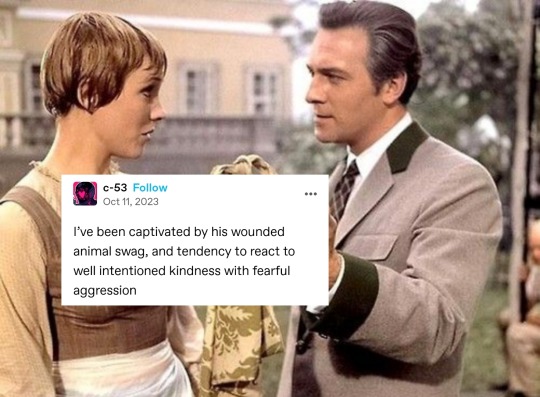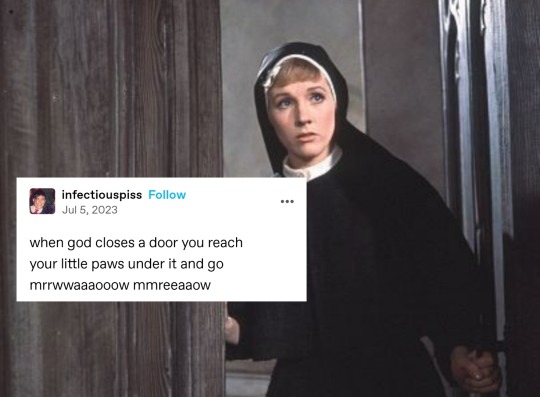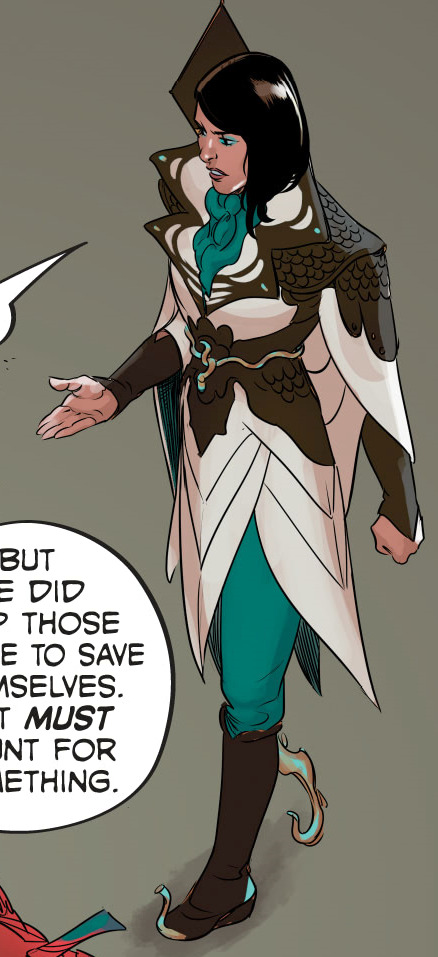#tsom analysis
Explore tagged Tumblr posts
Text






The Sound of Music + textposts pt. 1/?
#the sound of music#tsom crack#tsom analysis#<- mostly just the religiously devoted one lol#julie andrews#christopher plummer#tsom#tsomedit#sound of music#text post meme#tsom text posts
1K notes
·
View notes
Text
An overly complicated analysis of everything we know about Neve Gallus in canon, as well as some additional thoughts of mine on the themes surrounding her (because I am so gay for her already)
1. Canon information
- Her age is, as of yet, unknown. In the Tevinter Nights story The Streets of Minrathous, narrated in the first-person perspective by Neve, we read “He greeted me with a dismissive ‘young lady’ that made me think he’d forgotten my name” (216). However, this is a description by an older man, whose nephew is alive long enough that his “parents had disowned him years ago” (213). In another passage of the story, the following can be read: “The man was a con artist I’d turned in the year before. To be fair, he’d nearly gotten me killed the year before that, so we were even” (221). We can therefore be certain that she has engaged successfully in detective work for at least two years, and has likely been doing so for a while. We do not know when the story is set, neither do we know anything about the parallel stories of “The Wigmaker Job” and “Luck in the Gardens”. We get the information that a Venatori cultist was wearing clothes that are fading (220), and that the cult had long since lost much standing in society; it has likely been quite a number of years since 9:42. At the same time, we know of a Qunari invasion in the eastern part of the Tevinter Empire from 9:44/45 onward, with several major cities falling to the invaders. Neve describes the catacombs as “a place to hold a year’s worth of food and supplies, securing the city’s survival in case of blight or Qunari invasion” (232). A woman as observant and politically savvy as her would likely not frame an invasion as that much of a hypothetical in case of an ongoing war. It is reasonable to assume that the story takes place sometime around the middle of the forties. Which means that by the events of Veilguard, in the middle of the fifties, we should expect Neve to have had at least twelve years of experience as a private investigator, which places her likely age at minimum in the early thirties. (Not that I am hoping for anything 40 or upward, no, there is no MILF agenda here)
- She describes the manor of a rich man as “a residence nowhere near the third-rate bookseller where I rent a room” (216), locating her residence both outside of the rich parts of town, and informing us that she does not have the greatest of means.
- Likewise, we learn that her “family has more templars than mages. I’m sure that says a lot about me. The point is, I’m not from an old family and I felt as at home in Lady Varantus’s house as Jahvis looked” (218). Within the rigid social hierarchies of Tevinter, she is privileged by magehood, but not by blood. To the degree that Tevene social classes can be broken down so neatly into stratified categories, she seems to be somewhere in the lower ranks of the middle class.
- She is canonically disabled; an amputee wearing a prosthetic leg made of dwarven metal (215). In the comic The Missing #4, we see her prosthetic, it is designed as a cobra standing up in intimidation of an attacker, and the metal seems to be predominantly a bronze or gold with blue or silver accents (6). On her foot on the other leg, she is wearing a boot which has a bronze or gold tip symmetrical to the tail of the cobra, and a high plattformed heel (ibid). Combining that with the fact that she fights and runs with a prosthetic and a heeled boot (TSoM 215, TM4 16), we learn that she expresses immense control over her body.
- Likewise, she approaches all her actions, her appearance, and her communication verbal and physical with a high degree of precision and deliberation. Her outfit is perfectly composed, with white and dark leather as primary colours, the same blue-gold metal that her prosthetic is made out of for accents as well as her belt (which is a coiling snake, TM4 6), a dark turquiose for some of the cloth (such as pants and cravat), a light turquiose for such accents as her fingernails and her meticulously applied eyeliner, and some manner of cap akin to a graduation cap at the right side of her head, in an almost black brown, with gold details. The shape of the cap has the exact same angles as a rhombus as her earrings (TM4 9). The detail on the cap forms a snake. It has been posited by tumblr user @cleric4vampire that even her movement in the trailer reinforces the cobra/snake motive (https://www.tumblr.com/cleric4vampire/752850000700194816). Despite sometimes excrutiatingly long workdays (223), Neve puts an extreme amount of emphasis on her appearance. Even in the comic, while the style does feature very dynamic character movements while talking, her gestures stick out as particularly deliberate; she talks with her hands a lot, and with deliberation (see the appendix of this post for more). This speaks to a plethora of willpower, control, and a desire to maintain a controlled barrier between the self and the larger world.
- While writing this, I have come up with the theory that the blue accents of her apparell might partially be lyrium. If she is literally wearing lyrium makeup, I will marry her.
- The only two offensive types of magic that we see her use are ice magic (e.g. TSoM 226, 227, 235, TM4 16, 17), and a manner of magic that lets her freeze the moisture in the air around a person to stagger them (e.g. TSoM 214, TM4 17). Through cooling the air around herself a bit less, she manages to hide herself in mist (e.g. TSoM 214). She is capable of some healing magic (227).
- She has a network of contacts, acquaintances, and informants all over Minrathous, particularly in its underground.
- She loves salty fried fish (221). This is not only in line with Minrathous being a coastal capital, which has a distinct influence on the caloric inflow into the city and cuisine at large, but also, once again, stresses that she does not have much money at her disposal, by emphasizing that she eats fried fish from a cheap street food stall very regularly (221), which she calls her “fish dinners” (228).
- She canonically has straight dark brown hair, meticulously kept at the left side of her face to keep space for the cap on the right, brown eyes, and brown skin. It is furthermore canon that anyone who has a problem with that or wishes to change that with mods will be exploded via elemental magic. It is furthermore canon that I will not buy Veilguard if the game whitewashes her.
- She is involved with the Shadow Dragons in helping fugitive slaves (TM4 9, 20). She expressly approves of the use of armed violence against the institution of slavery. At one point, she comments: “The cult’s dead god wanted to bring Tevinter back to what it was—to its “glory.” It was nonsense, of course. It always was. The old empire was even more corrupt and heartless than what it is now, no matter how pretty the picture Corypheus painted” (TSoM 221). In her vocal resistance to the empire, she sees it as a good usage of her time to track down Venatori (214). In spite of her resistance against the empire, she considers the city her home and would like it to be better than it is (214, 221).
2. Themes: The noir detective and the empire
It goes without saying that the formational archetype behind the character of Neve Gallus is that of the noir detective. A solipsistic cynic with little means, a private investigator, called to investigate a crime scene in dance with and against the police, depending on the point of the story. The noir detective of the movies of the first half of the 20th century, the formational corpus from which stems the archetype, is distinctly tied to the metropolis; a story that needs the urban context, the urban scenery. While of course featuring a plentitude of settings and configurations, at the root of the archetype rest particularly a white, male, US-American figure. To bring Minrathous in parallel with New York particularly is in so far a welcome change as it means a partial departure from the orientalism underlying a lot of early descriptions of Tevinter in Dragon Age canon. But, to me at least, it raises the question of how well Dragon Age is equipped to tackle the arising thematic implications. Just like the Tevinter Empire, the United States of America is a slave society fueled by the deprivation of Indigenous communities and the physical exploitation of a racialized, disenfanchised class. The metropolis is the core of the imperial core; and Minrathous is, as the largest city of Thedas and the capital of Tevinter, certainly that. The Streets of Minrathous manages but a partial critique of the society of the imperial-colonial metropolis. While Neve remains critical of the templars, the undeniable cop stand-in, the critique remains bound to corruption the higher one goes in the chain of command, as well as the bureaucracy (231). The story, in particular, follows the very dangerous trope commonly found in copaganda that the base-level officers should be allowed to disobey the chain of command and act on their own, particularly when it comes to the deployment of heavy weaponry (234). That the base-level officer is as much an agent of imperial violence as the top of the hierarchy, turning the systemic and depersonal violence of the system into concrete interpersonal violence, cannot be formulated by the text.
Furthermore, the Venatori, in their supremacist-fascistic death cult, remain cast in ableistic terms that deprive their ideology of systemic connectedness: “that didn’t stop remaining loyalists from acting delusional and stirring up trouble when the mood struck. That’s fanatics for you” (213). That fascism is but the logical conclusion of empire, particularly a weakened and collapsing empire, remains just as unacknowledged. And yet, what haunts the story is a profound sense of loneliness and alienation. A rich man estranged and alienated from his nephew because of his fear of social repercussions for the nephews behavior, said nephew dying while grasping to any semblance of connection he can (“He knew what came next. He was searching for whatever company he had left” 215), Neve facing the cultists in their hideout alone because the templar Rana does not want to breach protocoll, hell, even the Venatori preacher making a ridiculous figure, alone and ignored on his soapbox while the masses rush by him and shut him out of their attention; everyone is lonely, seperated by the dividing and isolating forces of the empire. The imperial metropolis condenses people, yet they are emotionally distanced from one another. Neve’s final action in the story is to return to the rich old man, explaining to him that his nephew was trying to be good after all; a post-mortem attempt to mend but one severed connection between humans. Her entire character is defined by the trajectory that comes from wandering almost aimlessly in a desperate attempt to escape the solipsistic nature of the empire. Her defining emotional conflict is with the reality of empire, as much as her status as a brown, disabled, bisexual woman clashes with the roots of the figure of the noir detective. We see by the time of The Missing #4 that she finds a sense of fulfillment in working with the Shadow Dragons for the slaves and against the slavers, which hints at a character arc from TSoM to TM4. As Varric correctly observes, she has a heart of gold (TM4 20), one which she hides behind a particularly controlled facade, as stern as beautiful. How well her character plays out in Veilguard hinges entirely on the stories limited ability to discuss empire in meaningful terms, and the story’s willingness to further explore her emotional arc suggested between TSoM and TM4. I am furthermore worried about how well a series known for its overt centrism can handle the nuances that make her character so great, as well as fearing the reaction by gamers[TM] to having a brown, female, disabled, bisexual detective.
3. Appendix: I am gay for the way she talks with her hands and body

TM4 9

TM4 9

TM4 5

TM4 10

TM4 14

TM4 19
203 notes
·
View notes
Text
I didn’t like it!
I have thoughts and opinions
#and I don’t recommend the book to anybody let alone children#I may write a full analysis on it at some point just because I need to let it out somehow#the little white horse#tsom
13 notes
·
View notes
Text
One thing I love about The Ländler™ is that the main point of contact Maria and the Captain have in the majority of the dance is their hands and when they begin to touch more and more of each other is when the tone of the dance drastically changes. Even when Georg puts his hands on her waist, it's through Maria's hands, and everything is still lighthearted - they're smiling, at ease with each other, and comfortable.
One could argue the tone changes when Georg reaches behind his shoulder to join their hands for the final time before they begin the series of intricate turns and loops. But he still has a mischievous look on his face, though I will concede Maria looks worried - because she knows what is coming next.
However, I argue the full change occurs when they have multiple points of contact during the turns and loops (their arms, chests, etc.). Both have it clearly written on their face that they know something is going on between them. After all, it's the closest physically they've ever been and the most they have ever touched. This physical closeness causes the pretense between them to fall apart as they stare into each other's eyes, just for a moment, before Maria backs away with the excuse she doesn't remember anymore.
It's awe-inspiring.
#tsom#som#listen... i know i sound crazy but...#i love overanalyzing this movie#and chris and julie make it so easy because#there is so much nuance they have given these characters#som analysis
78 notes
·
View notes
Note
I absolutely love TSOM and am so grateful I found your scene analysis posts! I've read them all and oh my goodness they're so delightful! :) Thank you for sharing your insight, I'd love to read any additional ones that you create! <3
Aww thanks so much 💗 in the midst of finals right now but hopefully I’ll have some new ones up asap :)
3 notes
·
View notes
Text
SHUT UP YOU'RE SO RIGHT AND IT'S SO CUTE
now that im on my tsom crackheadedness yet again, ive found that this song is literally maria. give it a listen and tell me how right i am LOL
8 notes
·
View notes
Text
I remember seeing a post one time that said it was so terrible how Maria said she was frightened and ran away from a man and the reverend mother told her to go back and sometimes I think about that and get so annoyed... Maria said "I was frightened" and the reverend mother's FIRST reaction was a very frantic and worried "were they unkind to you?" And Maria said no very sincerely and then explained. The reverend mother isn't stupid she knows Maria very well. She knows when she's lying. And even tho the movie never said it specifically (besides Maria's "wicked childhood / miserable youth") in real life she was abused as a child so the reverend mother probably ALSO knows what Maria's trauma responses look like. She ALSO ALSO said that Georg was a "fine and brave man" and was comfortable sending Maria to work for him in the first place so already knew him and his character pretty well too!!! This woman oversees a community of all women including lots of young and confused women trying to escape something (including nazis!!!) and she obviously takes her responsibility seriously and she wouldn't just throw Maria into a potentially abusive situation!!!
90 notes
·
View notes
Text
The tag teaming and entire conversations being had with their eyes and Teamwork between Georg and Maria when Zeller catches them omggg. "I'm far too outspoken it's one of my worst faults" -> mouthing off sassily to a nazi and Georg being nothing but supportive of it. He doesn't have an answer for their travel clothes and he immediately looks at Maria and she immediately does have an answer. Their entire plan changed and they were on the same page without saying anything to each other. Or even like. Really looking at each other that much. They just kept 👀. 👀. 👀. Flicking their eyes over for half a second. GOD
13 notes
·
View notes
Text
The Reverend Mother is so slay for being like oh Maria there's only rules about postulants singing inside the Abbey. Yea there's also rules about postulants sneaking out of the Abbey but once you've done that go ahead and sing girlie who cares. Sins cancel each other out!!!
7 notes
·
View notes
Text
Do you understand how annoying you must have to be to be called a demon by a literal nun
12 notes
·
View notes
Text
Maria: I don't suppose I'm used to dancing
Georg:

11 notes
·
View notes
Text
Maybe if yall were more like me and read tsom fanfiction about gossiping socialites and reformed slutty high society men you'd appreciate cowboy like me more .
#the sound of music#tsom crack#?#tsom analysis#is calling georg a reformed slutty high society man analyzing
13 notes
·
View notes
Text
Maria and Georg fight so well I wanna see them have an actual Married Couple™ fight. Like not over smth extremely important but they're both really mad and Yell At Each Other. They'd slay.
9 notes
·
View notes
Text
Georg's hands at Maria's neck in the gazebo scene 😵💫😵💫😵💫
3 notes
·
View notes
Text
Oh my GOD Maria's face when Georg walks inside to see the kids singing I'm crying i love her
2 notes
·
View notes
Text
If The Sound of Music was actually a Christmas movie then Maria and the kids would have died immediately after falling out of the rowboat upon hitting winter Austrian lake water. Or cracked their skulls open on the ice of a lake in an Austrian winter
#ok wait winter au where theyre ice skating instead of in a rowboat and one of the kids falls through the ice#much more dramatic 😈#the sound of music#tsom on abc#tsom analysis
4 notes
·
View notes